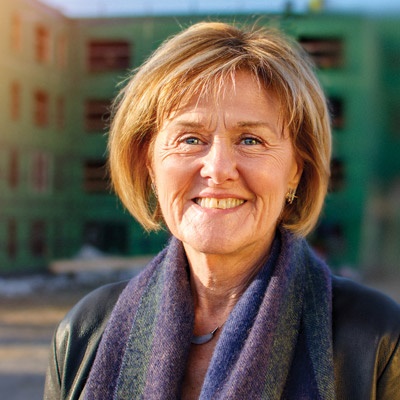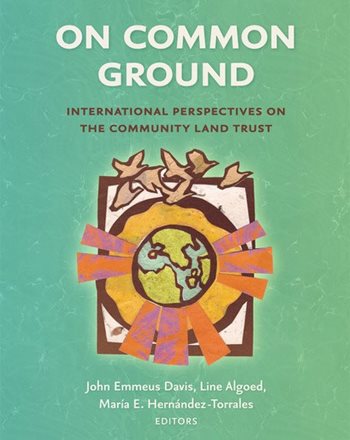Brenda M. Torpy, founder and chief executive officer of Vermont's Champlain Housing Trust (CHT), a NeighborWorks organization in Burlington, contributed an essay to the newly released book, "On Common Ground: International Perspectives on the Community Land Trust." Torpy shared thoughts about her work on the book and about the way community land trusts offer a creative affordable housing solution.
Community land trusts are one of several models of shared equity housing that NeighborWorks is supporting through its new Shared Equity Housing Initiative. The initiative supports networks in building their knowledge and capacity around using shared equity and cooperative housing models to create lasting affordable housing, build wealth for families with modest incomes, and stabilize neighborhoods.
Would you explain the difference between a conservation land trust and a community land trust?
With a conservation land trust, land is taken out of the market for environmental purposes, to save land for natural habitat, for wildlife. A community land trust takes land out of the market for community purposes, primarily housing, neighborhood development or agriculture. It's hybrid: a collectively owned land but with individually owned houses or enterprises. The idea and practice is that the community controls it together with a vision for the common good. CLTs (community land trusts) are typically membership organizations that elect a board of directors made up of representative stakeholders of the community including residents of CLT homes. This is not unlike most NeighborWorks organizations.
Is Champlain Housing Trust still the largest community land trust in the United States?
Yes, and probably in the world. We have over 3,000 homes now, growing every year, and we have 6,000 members.
 How – and why – do community land trusts work?
How – and why – do community land trusts work?
We keep all the land permanently in the nonprofit and out of the market, but we provide the opportunity for homeownership. People can buy a home on land-trust land. They get their own mortgage, build equity, own the house and their children inherit it. At resale, the house will not go to the highest market price because the ground lease between the owner and the CLT includes a resale formula designed to balance wealth building for the seller with affordability for subsequent buyers. Just as with other homeownership access programs, CHT provides a purchase subsidy to the buyer, but unlike conventional programs, CHT recycles that benefit to assist many more households over time. In this way, we are also creating and managing a stock of permanently affordable homes for communities that want to maintain access to homeownership for their workforce.
Across the U.S., cities and metro areas are increasingly looking at CLTs and similar models especially in hot and gentrifying markets that disproportionately exclude and/or displace minorities. Our trust also does many affordable rentals to protect vulnerable renters from displacement and, through the security of tenure and affordable rent, help people to save and access the opportunity of ownership. We also have many small businesses, nonprofit facilities, parks and other community amenities on our land, including shelters, transitional and service enriched homes. We see the entire portfolio as a continuum of housing security and opportunity. One year, four households that had first come to us for emergency shelter became homeowners.
Why are community land trusts important when it comes to long-term affordable housing?
Land trusts are important because in all the desirable markets in the country where there are good jobs and good schools, home ownership is becoming increasingly out of reach of people ― and good rental housing, too. People have no security of tenure as renters. When you pay 60 to 70 percent of your income on rent, it's hard to save for homeownership. The importance of a land trust today is that you can create and preserve housing opportunities for the common good, not just to feed the market, and you can also protect whole neighborhoods from gentrification while making them places of opportunity.
Tell us a little about the history of your organization.
Champlain Housing Trust started as Burlington Community Housing Trust back when Sen. Bernie Sanders was mayor of Burlington. Housing was a big issue in the city and he created a community development office to engage residents in community development solutions that would be citizen led and endure beyond the cycles of government, but with the full support of government. As housing director, I was charged with helping the residents ― mostly low-income renters ― of the Old North End improve their housing and neighborhood without displacement. We came upon the community land trust model through the Institute for Community Economics. We really thought this nonprofit, community-led model met the needs of our community. We put the idea out to the public and people were like, "Yeah, let's get started. Let's do this." A related issue that made the CLT relevant was the double-digit mortgage rates of that decade (1980s) putting homeownership out of reach for too many.
What got you interested in the field of housing affordability?
I wanted to work for social and economic justice, and I started in Vermont as a community organizer at a rural anti-poverty agency and its spinoff nonprofit where I learned about housing. I saw firsthand the difference that housing security made to people's basic well-being and their prospects for any opportunity. The security of home is an immediate and practical benefit to each person and family we help, and ― in the bigger ― picture equal access to land and housing is essential to a just society.
 Tell us a little about "On Common Ground," and how your chapter fits in.
Tell us a little about "On Common Ground," and how your chapter fits in.
The book covers the history of the [community land trust] model, different rural and urban applications, the model's relation to other forms of collective ownership and explores where we are headed. Most of the contributors are active practitioners like myself who have had the experience of adapting the model to our local needs be they urban or rural, the hot markets of North America and Western Europe and now, increasingly, in the Global South. CHT is one of the urban examples although now we cover the northwest region of Vermont that also includes suburban and rural markets.
How do you think the book will help readers, particularly NeighborWorks organizations?
If you are in a gentrifying neighborhood or a high-cost market, this is another great tool to expand homeownership. It's timely in our rethinking of how we do community development and affordable housing in terms of race and equity. We need new tools to broaden access to homeownership and to protecting people's neighborhoods from being swept away. This is a great tool for any homeownership center. We help people buy in the open market but for those who cannot afford our hot market the shared-equity option allows them to convert their monthly rent payment into an equity building mortgage (often for the same cost or less). This program, now a portfolio of 630 homes earns income that supports our counselling activities.
Do you think that affordable housing professionals know enough about land trust opportunities?
It's a different kind of solution that has not become well known yet. There are still a lot of misconceptions about the program, for example, that buyers do not build wealth and become trapped as a result in a "lesser form of ownership." However two thirds of our sellers go on to buy in the market with the equity they gained this way. Also, they are far less likely to lose their wealth in a downturn as post financial crash studies showed. Many also balk at the initial subsidy needed to make this work for people, usually about 20 percent. That is small compared to what we spend on creating rentals with tax credits.
What else do you like about the land trust model?
I like the mix of collective and individual ownership. This creates a more secure ownership ― true full-cycle lending and builds community. Our board of directors is collectively responsible for $300 million in real estate assets and stewards them for the community. Finally, the model is very adaptable and can be shaped to local needs and conditions. I've worked with communities in other countries developing trusts where there are really different property laws and regimes, and the model has to be adapted to each context. It's incredibly flexible. You have an impact on development in your community collectively; that's the common thread.
Where can we find the book?
Learn more about the book at Terra Nostra Press.
Our goal is to make it very accessible and affordable so it will be a good resource in the field. There are audio versions of some of the chapters, and some are translated into Spanish and French. There's a paperback, as well as an e-reader edition and sizeable discounts for nonprofits.
07/14/2020

